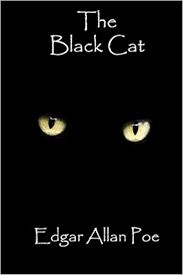The Black Cat - Edgar Allan Poe
Introduction :
Edgar Allan Poe’s The Black Cat is a gripping tale of psychological horror, guilt, and madness. First published in 1843, this short story delves into the dark recesses of the human mind, exploring themes of violence, alcoholism, and moral decay. Poe’s masterful use of Gothic elements, unreliable narration, and macabre symbolism makes The Black Cat a timeless classic in horror literature.
1. The Plot: A Descent into Madness
The story is narrated by an unnamed man awaiting execution, recounting the events that led to his downfall. He begins as a kind and affectionate person, particularly toward animals. However, his character deteriorates under the influence of alcohol, turning him into a cruel and violent man.
His pet black cat, Pluto, becomes the first victim of his growing rage. In a drunken fit, he gouges out one of the cat’s eyes and later hangs the poor creature from a tree, symbolizing his complete moral collapse.
Soon after, his house mysteriously burns down, leaving behind a strange imprint of a hanged cat on the wall. Haunted by guilt but refusing to acknowledge it, he acquires another black cat with similar features, except for a white patch on its chest shaped like a gallows. This new cat becomes a living symbol of his crime and guilty conscience.
In a fit of rage, he attempts to kill the second cat but ends up murdering his wife when she tries to stop him. He buries her body behind the wall of his cellar, believing he has successfully hidden his crime. However, his overconfidence leads to his undoing when police search the house and hear a ghastly cry from within the wall—the sound of the second cat, revealing the murder and sealing the narrator's fate.
2. Major Themes and Symbolism
a. Guilt and Psychological Horror
The narrator’s descent into madness stems from his inability to suppress guilt. His belief in escaping consequences contrasts with the inevitable justice that unfolds, highlighting Poe’s exploration of the human mind’s capacity for self-destruction.
b. Alcoholism and Moral Decay
Alcohol is a driving force behind the narrator’s downfall. His increasing dependence on alcohol leads to the erosion of his moral compass, turning him into a remorseless criminal. Poe critiques how addiction can distort reality and unleash inner demons.
c. The Supernatural and Fate
While the events seem grounded in psychological horror, the eerie presence of the second black cat suggests supernatural forces at play. The white patch shaped like a gallows symbolizes fate, inescapable judgment, and divine retribution.
d. The Unreliable Narrator
The story's narrator claims sanity while recounting his horrific deeds. His distorted version of reality keeps readers questioning the truth, a hallmark of Poe’s Gothic storytelling style.
3. Gothic Elements in The Black Cat
Poe’s use of Gothic conventions elevates the story’s intensity:
- Dark Setting: The narrator’s crumbling house and the gloomy cellar create an oppressive atmosphere.
- Violence and Death: Grisly acts of murder heighten the macabre tone.
- Supernatural Undercurrents: The black cat seems to embody a vengeful spirit, adding an eerie, almost otherworldly quality.
- Mental Torment: The psychological disintegration of the narrator mirrors the haunted landscapes typical of Gothic tales.
4. Why The Black Cat Endures
More than just a ghost story, The Black Cat is a psychological exploration of guilt and moral collapse. Poe’s intricate narrative, filled with suspense and symbolic imagery, continues to captivate readers with its chilling portrayal of the human psyche.
Whether read as a supernatural horror or a cautionary tale about inner demons, The Black Cat remains a classic in Gothic literature, inviting readers to explore the thin line between sanity and madness.
Conclusion
The Black Cat is more than a tale of horror; it is a profound exploration of the human psyche, guilt, and the consequences of moral corruption. Edgar Allan Poe’s genius lies in his ability to intertwine these elements into a gripping narrative that resonates with readers across generations.



No comments:
Post a Comment